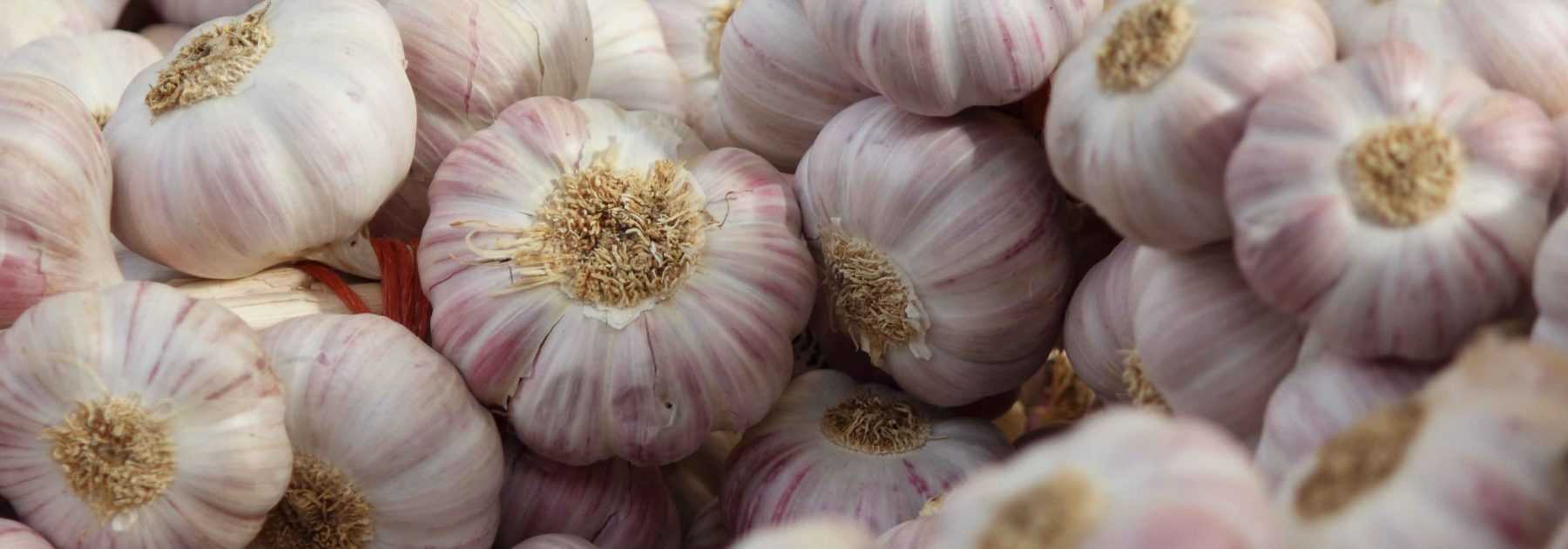
Garlic: Planting, Growing and Harvesting in the Vegetable Garden
Contents
Garlic in a nutshell
- Garlic is a pungent, strongly flavoured root vegetable used as a seasoning with multiple health benefits.
- It thrives in sunny spots, in well-loosened, light, well-drained soil without fresh manure.
- Garlic has two planting seasons: purple and white garlic in autumn, pink garlic in spring.
- Maintenance is limited to regular weeding and hoeing, plus watering during dry spells.
- It can be harvested at different maturity stages – as young shoots (“aillet”), fresh/green for autumn varieties, or most commonly when dried.
Our expert's word
Garlic is a root vegetable from the Liliaceae family, which includes many other edible and aromatic plants such as onions, shallots, leeks, spring onions, and chives. There are different types of garlic, including white garlic and purple garlic, which are the strongest, and pink garlic, which has a milder taste. Garlic is used as a condiment, either raw or cooked, as young garlic, green garlic, or most commonly, dried garlic. It enhances and flavours many dishes, notably in aïoli and snail butter.
Growing garlic is not difficult, provided you have loose, well-drained soil, free from fresh manure and exposed to sunlight. White and purple garlic are planted in autumn, while pink garlic is planted in spring. The first two types yield a very good harvest, whereas pink garlic produces smaller cloves that store for longer. As a gardener, it’s worth experimenting with different varieties to find those best suited to your growing conditions. You may be lucky enough to find that all types thrive in your vegetable garden—if you love this condiment, don’t hesitate to diversify!
The reputation, quality, and expertise in garlic production are highlighted in France with four PGIs (Protected Geographical Indications). These include Lomagne white garlic, Drôme garlic, Lautrec pink garlic, and Arleux smoked garlic, as well as an AOC (Appellation d’Origine Contrôlée) for Cadours purple garlic.
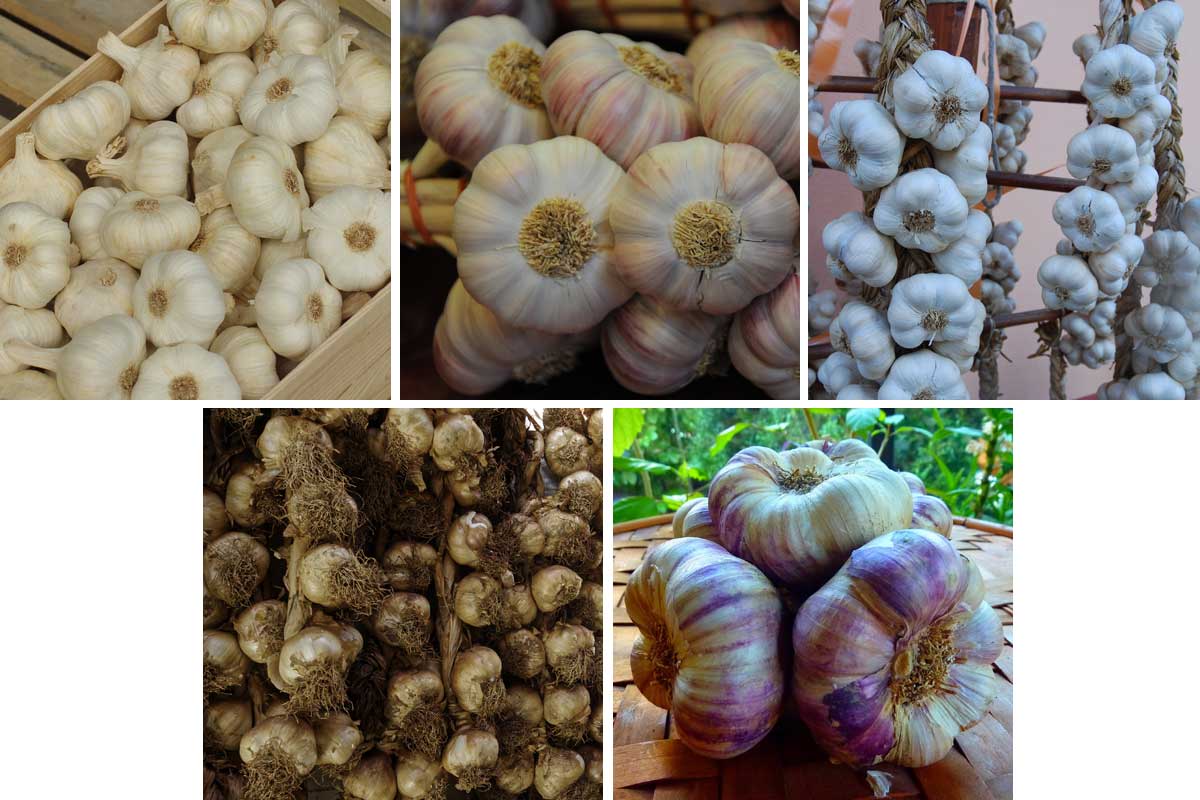
Drôme garlic – Lautrec pink garlic – Lomagne white garlic – Arleux smoked garlic – Cadours purple garlic
Description and botany
Botanical data
- Latin name Allium sativum
- Family Amaryllidacées ou Liliacées
- Common name Ail
- Flowering vivace cultivée en annuelle ou bisannuelle
- Height les caïeux se conservent plusieurs mois
- Exposure soleil
- Soil type meuble, léger, se ressuyant rapidement
- Hardiness rustique
Garlic is a plant native to various regions of the globe, believed to originate from Central Asia, the Mediterranean, the Caucasus and Afghanistan. The first traces of garlic cultivation date back 5000 years, in ancient Egypt where it was consumed by pyramid builders to increase their strength and immune defences. Its cultivation then spread through the Greeks and Romans, before progressing throughout the rest of Europe.
The common name “garlic” comes from the Latin name, Allium, whose origin is uncertain. It may derive from the Latin olere, “to smell” or from the Greek hallesthai, “to spring up”. The Greeks called garlic “scorodon”. The species name, sativum, means “to cultivate”. Un ail… des aulx or des ails. Both plural forms are accepted. The first version is older, while the second, initially used in botany, is becoming more widespread.
Garlic – Allium sativum var. sativum – is a root vegetable from the Liliaceae or Amaryllidaceae family (in phylogenetic classification), like onions, shallots and leeks. This herbaceous, monocotyledonous plant is a bulbous, perennial and very hardy, though it is cultivated as an annual or biennial. Garlic takes the form of a bulb or “head”, composed of several cloves called caïeux. These are planted in the ground and develop into new garlic heads.
The erect, linear leaves sheath the stems and are fragrant when crushed. Some garlic varieties form an inflorescence, such as the ‘Rose de Lautrec’ variety. Others fail to produce a flower stalk, particularly white garlic varieties like ‘Thermidrome’ and ‘Germidour’. Cultivated garlic varieties are uniquely classified into five groups based on their enzymatic profile and botanical characteristics. The presence or absence of a flower stalk is included in this classification. From the floral stem, 30 to 80 cm tall, blooms an umbel with mostly sterile white or pink flowers that blossom in summer. Between the flowers are floral bulbils that fall to the ground and produce new plants, particularly in the case of rocambole garlic.

Garlic heads with clearly visible cloves – garlic plant in cultivation
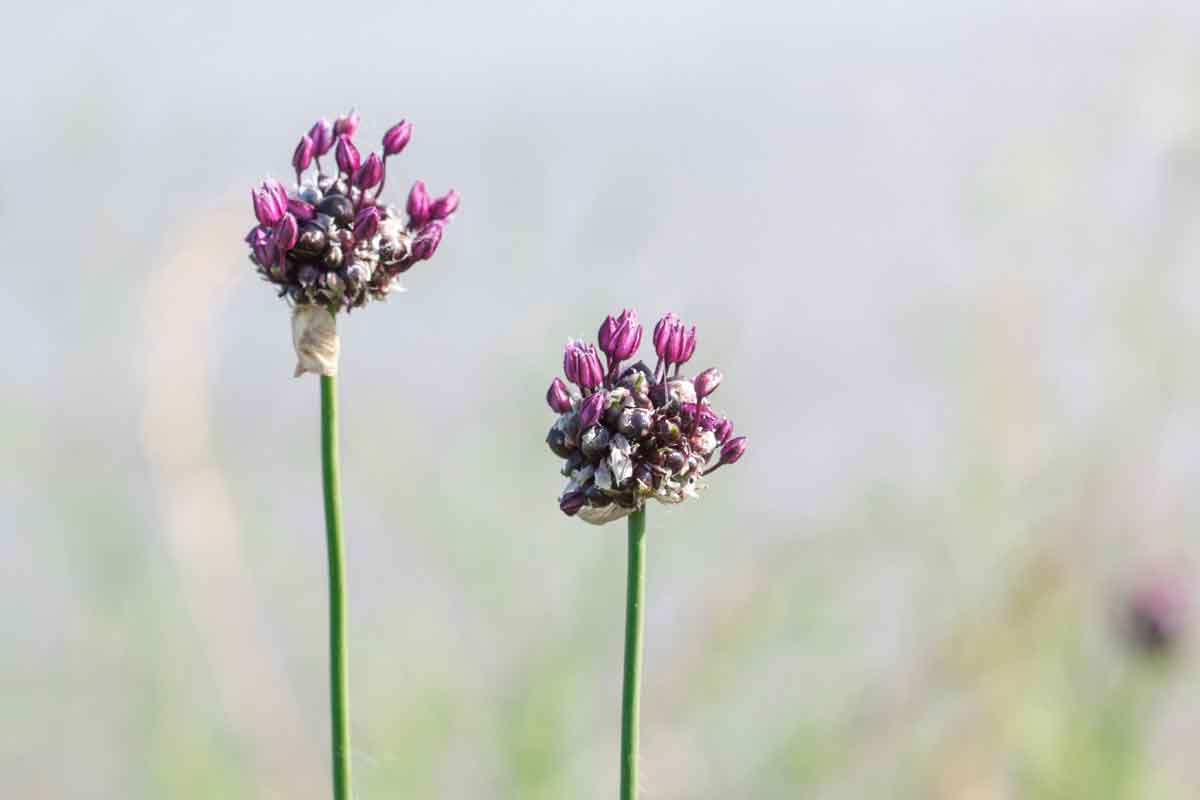
Rocambole garlic flowers interspersed with bulbils
Garlic varieties
The choice of varieties is based on one primary criterion: the planting season. White and purple garlic varieties are planted in autumn, while pink varieties are planted in spring. Other species, such as perennial rocambole garlic and wild garlic (ramsons), can remain in the garden for several years.
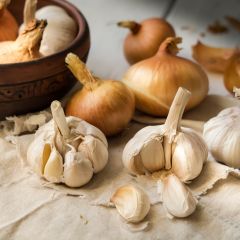
Spring Garlic - Allium sativum
- Height at maturity 30 cm

Gayant Pink Garlic plants - Allium sativum
- Height at maturity 30 cm
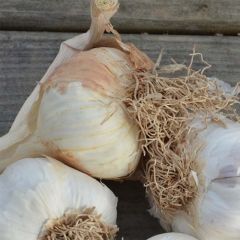
Arno Pink Garlic - Allium sativum
- Height at maturity 30 cm
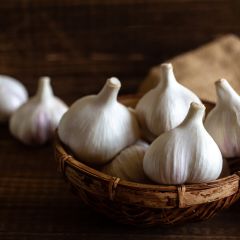
Garlic Flavor - Allium sativum
- Height at maturity 30 cm

Germidour Garlic plants (autumn planting) - Allium sativum
- Height at maturity 30 cm

Messidrome Garlic plants (autumn planting) - Allium sativum
- Height at maturity 30 cm

Bear's Garlic - Allium ursinum
- Flowering time May, June
- Height at maturity 20 cm
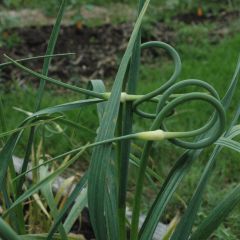
Rocambole Garlic - Allium scorodoprasum
- Height at maturity 80 cm
Discover other Garlic Heads
View all →Available in 1 sizes
Available in 2 sizes
Available in 1 sizes
Available in 2 sizes
Available in 1 sizes
Available in 1 sizes
Available in 2 sizes
Available in 1 sizes
Available in 1 sizes
Available in 2 sizes
Planting garlic
Companion Planting with Garlic in the Vegetable Garden
Garlic gets along well with plants from the Rosaceae family, as it helps prevent fungal diseases in fruit trees and berries such as apple trees, pear trees, peach trees, raspberries, strawberries, and even rose bushes. To improve tomato quality, it is recommended to plant a garlic bulb at the base of each tomato plant. Use the inner cloves for these companion plantings, and save the outer cloves for your garlic rows intended for consumption.
Garlic can also be a poor companion for certain vegetables. Indeed, many gardeners agree that Fabaceae (beans, broad beans, and peas) and Brassicaceae (cabbages, turnips, rocket, radishes) generally dislike the presence of garlic and other plants from the Liliaceae family. Avoid planting them nearby.
Growing and Caring for Garlic
Hoe and weed regularly, especially at the beginning of cultivation. Weeding should be gentle and shallow near the plants, as garlic roots grow close to the surface.
Water garlic only during prolonged dry spells, from May onwards. Mulching is possible in light soil from May, once the soil has warmed sufficiently. For this, preferably use dry mulches like straw. Avoid damp grass at all costs!
Avoid planting garlic near leeks or onions, as they are susceptible to the same diseases.
Never spray nettle manure on garlic, as the smell of this extract attracts onion flies.
Some gardeners tie or bend the foliage two weeks before harvest to concentrate sap in the bulb and thus increase bulb size. This is a fairly common practice, though it is not scientifically proven to actually enlarge the bulbs. Another advantage of this technique is that it helps dry the foliage more quickly as harvest approaches.
→ Learn more in our tutorial: How to Harvest and Store Garlic?
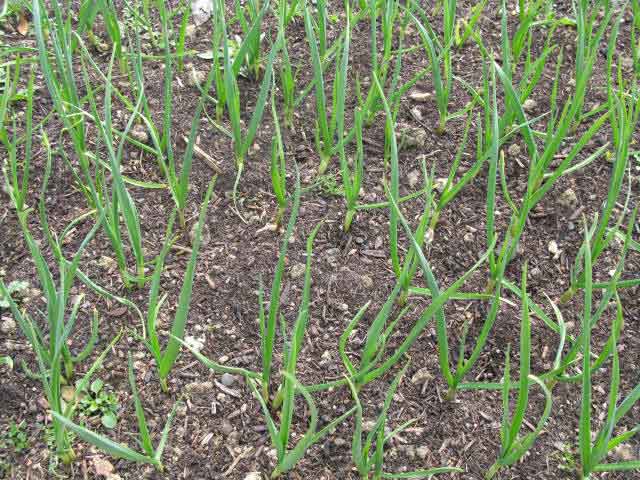
Garlic during cultivation
Common Diseases and Pests of Garlic
Garlic Rust
It’s ironic that this vegetable, renowned for its excellent antifungal properties, should be so susceptible to rust, a fungal disease!
The culprit behind rust is the fungus Puccinia allii, which thrives in damp weather when temperatures hover around 18°C. It is most commonly encountered in spring, and depending on the severity of the attack, this disease can significantly harm the harvest. However, if rust appears just a few weeks before harvest, its impact will be minimal. There are regions where this disease is particularly frequent and aggressive.
The symptoms are easy to spot, appearing as small rust-coloured spots and pustules on the leaves. In severe cases, the spots merge and eventually cause the leaves to dry out completely, which inevitably affects the development of the cloves.
To combat garlic rust:
- As a preventive measure, avoid wetting the foliage when watering.
- Always adhere to a crop rotation of 4 to 5 years between garlic plantings (and with other allium family vegetables).
- In biodynamic farming, a horsetail decoction is used to prevent its appearance. Horsetail keeps the fungus in its natural environment—the soil.
- If the disease develops, don’t wait for it to spread. Remove the affected parts carefully, avoiding contact with the pustules to prevent contaminating healthy areas. Dispose of infected material.
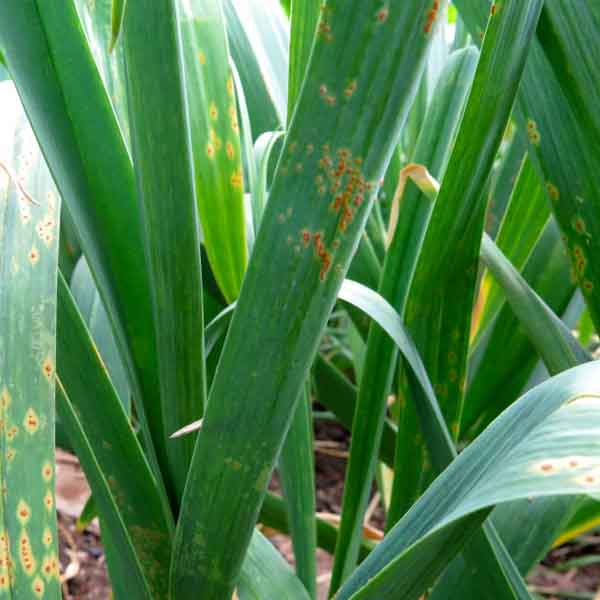
Rust pustules on garlic leaves
Onion Fly
The onion fly—Delia antiqua—is a pest that attacks garlic and can cause significant crop loss. The fly larvae are responsible for the damage. Symptoms include an overall weakening of the plant. The leaves turn yellow, and the plant eventually dies. When these signs appear, simply uproot the infected plant to find maggots feeding on the bulb. Destroy contaminated plants to prevent the larvae from spreading. Unfortunately, the larvae have an uncanny ability to move from one plant to another!
To prevent onion fly infestations:
- Avoid applying nettle manure to garlic crops, as its odour attracts these flies.
- An infusion of tansy is an effective preventive treatment.
- Insect-proof mesh remains the best solution if the problem is recurrent in your vegetable garden.
Harvesting and Storing Garlic
Garlic can be harvested at different stages of maturity from April until July:
- Green garlic (grown from inner cloves) is harvested when the stems reach 20 to 30 cm in height.
- Fresh garlic is harvested from autumn-planted garlic (white and purple varieties) in April and May, while still green with formed cloves but before the bulbs separate.
- Garlic scapes (from pink varieties) are harvested in May and June.
- Cured garlic is harvested when the leaves have withered. Lift the bulbs and let them dry for a few days on dry soil in the shade (to avoid sunburn). They can be braided and hung to aid drying.
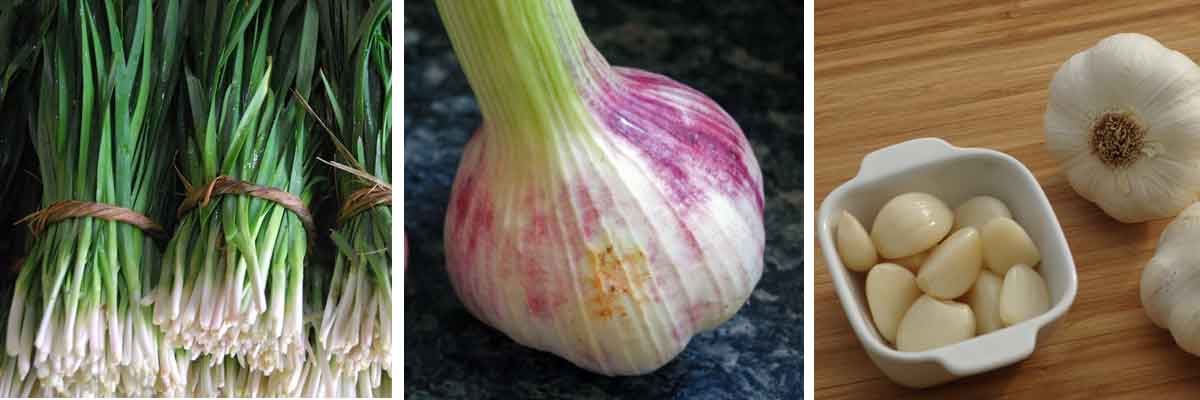
Garlic is harvested at different stages: Green garlic – Fresh garlic – Cured garlic
Garlic bulbs can be stored for several months and up to a year. Pink and purple varieties keep better than white garlic.
To store cured garlic properly:
- Keep garlic away from light to prevent cloves from turning green over time.
- Store in a well-ventilated area to reduce the risk of mould.
- Damaged bulbs should be set aside and used first to avoid contaminating other cloves.
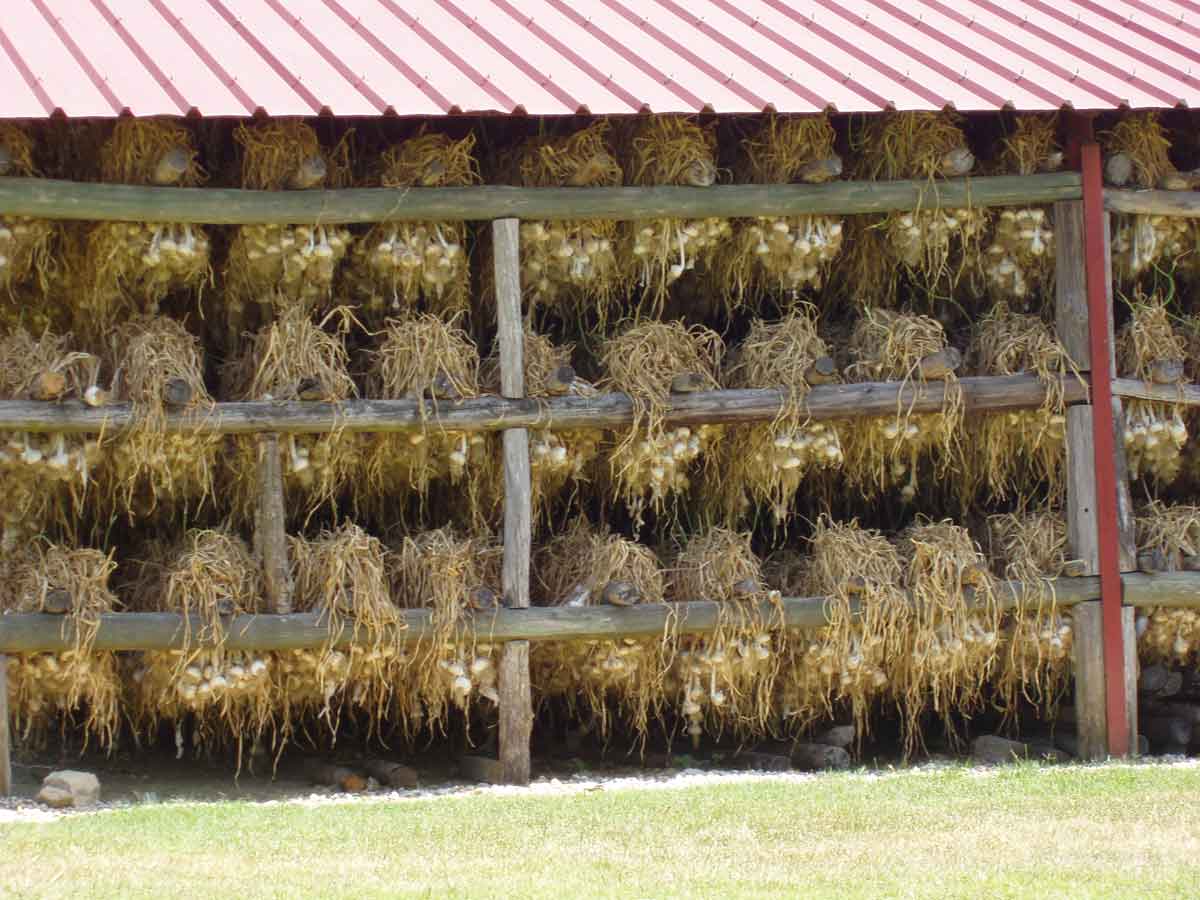
Proper drying is essential for good garlic bulb storage.
Uses and benefits
Garlic is a key ingredient in many dishes and sauces, an essential component of aïoli, that famous Mediterranean sauce, or rouille, which enhances bouillabaisse, not to mention snail butter. In spring, enjoy harvesting your green garlic to eat it raw by mixing it into salads or adding it to dishes at the end of cooking. When harvested at maturity, there’s no need to remove the germ for the first few months; later, when sprouts form, removing the germ makes garlic easier to digest. It’s best used finely sliced or crushed in a garlic press and always added at the end of cooking to preserve its flavour and numerous health benefits.
We’re all equal when it comes to the temporary halitosis caused by garlic, but despite this drawback, this powerful condiment has multiple health benefits. You can reduce bad breath by eating parsley! Pink garlic is also milder than white garlic.
Garlic is very rich in selenium and sulphur compounds, including many antioxidants. It contains a good amount of vitamins A, B and C. It’s an excellent prebiotic due to its inulin content. It’s safe to say that Lebanese garlic sauce (made with yoghurt) would be ideal for strengthening gut flora! It’s also known for its powerful antibacterial and antiviral effects, particularly against the common cold virus. Garlic is also very good for the heart—it thins the blood, lowers blood pressure and reduces cholesterol levels. According to various scientific studies, daily garlic consumption could halve the risk of digestive cancers, including stomach, colon and rectal cancers, though it should be eaten raw.
→ Also discover Garlic Purin or Garlic Decoction: Recipe and Garden Uses and How to Make 100% Homemade Garlic Powder? in our tutorials!
Useful resources
- Discover our range of garlic, including bulbs for common garlic, plants or seeds for wild garlic.
- Our advice sheet: Garlic, the best varieties
- Garlic and Egyptian walking onions: successfully growing two perennial vegetables
- How to propagate garlic? Our tips and techniques
Frequently asked questions
-
My garlic cloves are turning translucent, what's happening? Are they still edible?
A garlic clove turning translucent is caused by mould. This translucent garlic is no longer edible - you can tell by its smell, which loses the characteristic aroma of healthy garlic. We recommend storing your garlic in a well-ventilated area after harvesting.
- Subscribe!
- Contents


































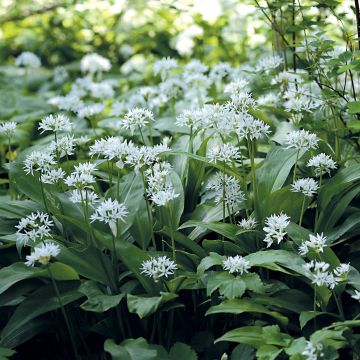
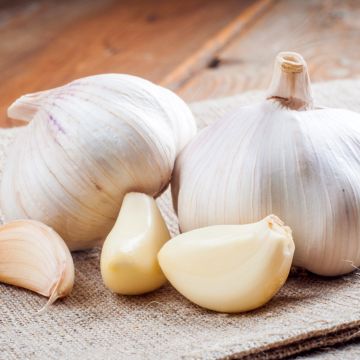
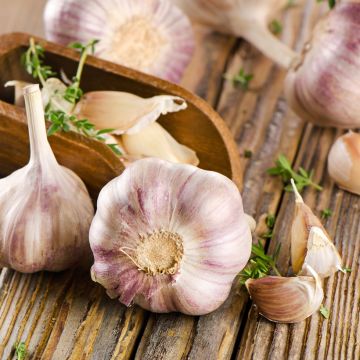
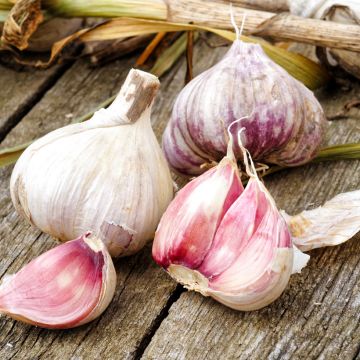


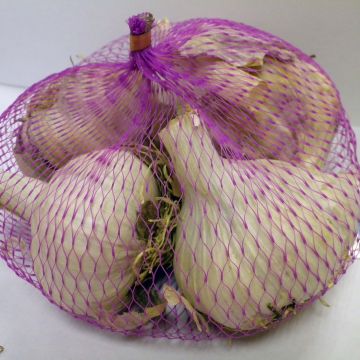



Comments